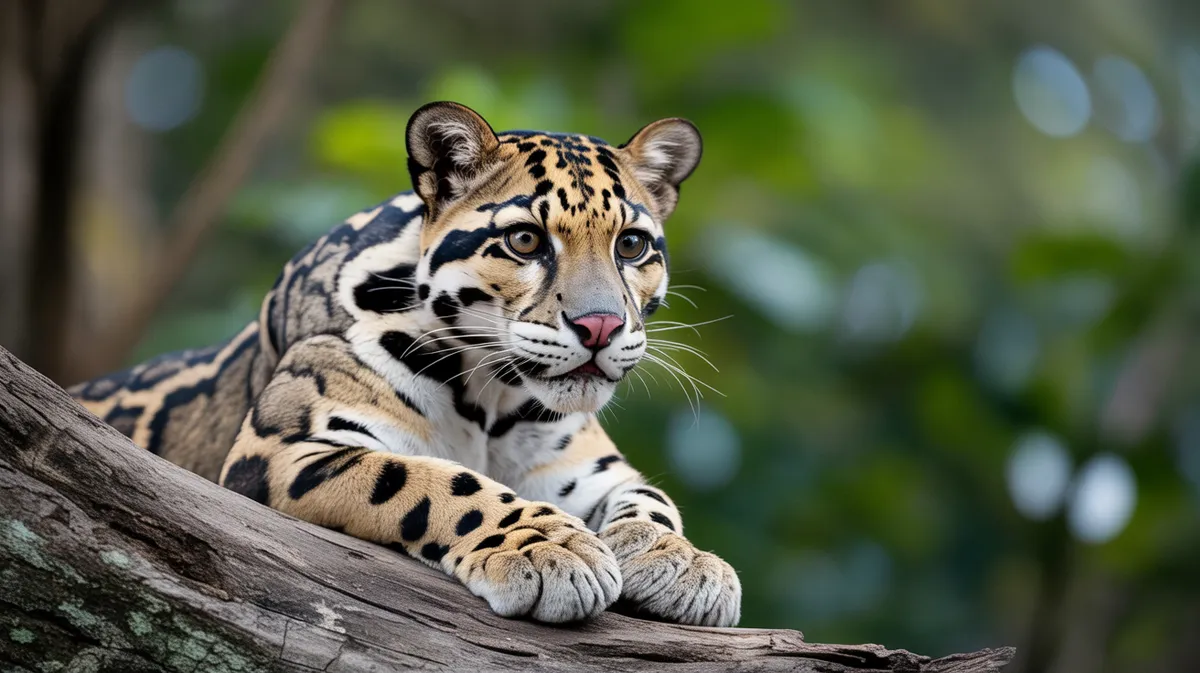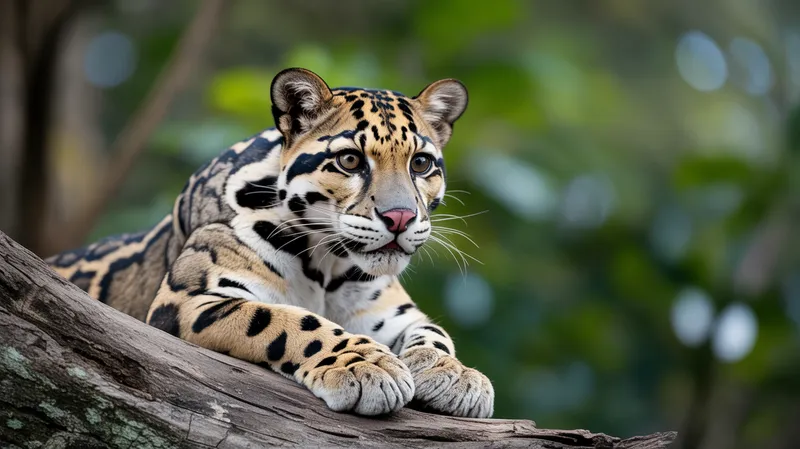
Clouded Leopard
Neofelis nebulosa

Meet the Clouded Leopard
The clouded leopard is a medium-sized wild cat native to the dense forests and foothills of Southeast Asia. Renowned for its striking cloud-like markings on its golden-yellow coat, the clouded leopard is an agile climber and often spends much of its time in trees. Its unusually long canine teeth, proportionally the longest of any living feline, give it a prehistoric appearance. This elusive predator is mostly solitary and is rarely seen in the wild, contributing to its mystique among big cats.
Classification
Mammal
Habitat
Tropical and subtropical forests
Diet
Carnivore
Lifespan
11-17 years
Conservation
Vulnerable
Weight
11-23 kg
📖Fascinating Facts
Masterful Tree Climber
Clouded leopards are exceptionally skilled climbers, able to descend trees headfirst and leap between branches with ease.
Saber-like Canines
Their upper canine teeth can reach up to 4 centimeters, resembling those of extinct saber-toothed cats.
Mysterious and Elusive
Due to their secretive nature and dense habitats, clouded leopards are rarely observed in the wild, making population estimates challenging.
📋Detailed Description
The clouded leopard (Neofelis nebulosa) is a medium-sized felid distinguished by its striking, irregularly shaped, cloud-like markings on a background of tawny to greyish fur. Adults typically weigh between 16 and 23 kg, with males generally larger than females. The species is notable for its exceptionally long canine teeth, which can reach up to 4 cm—proportionally the longest of any extant cat, reminiscent of the extinct saber-toothed cats. Its limbs are short and robust, with large, dexterous paws and sharp, retractable claws, adaptations that facilitate an arboreal lifestyle. The tail, which can be as long as the head-and-body length (up to 91 cm), serves as a counterbalance when maneuvering through trees. Clouded leopards are primarily nocturnal and crepuscular, resting in dense foliage or tree hollows during the day. Their solitary nature is typical, with individuals maintaining large, overlapping home ranges. The species is highly elusive and rarely observed in the wild, contributing to gaps in behavioral knowledge. Their vocalizations include growls, hisses, and a distinctive 'prusten' or chuffing sound, used in communication.
💡 Did you know?
A clouded leopard's ankles can rotate backwards, allowing it to climb head-first down trees and hang upside down from branches.
🔬Research & Sources
Wikipedia Summary
The clouded leopard, also called mainland clouded leopard, is a wild cat inhabiting dense forests from the foothills of the Himalayas through Northeast India and Bhutan to mainland Southeast Asia into South China. It was first described in 1821 on the basis of a skin of an individual from China. The clouded leopard has large dusky-grey blotches and irregular spots and stripes reminiscent of clouds. Its head-and-body length ranges from 68.6 to 108 cm with a 61 to 91 cm long tail. It uses its tail for balancing when moving in trees and is able to climb down vertical tree trunks head first. It rests in trees during the day and hunts by night on the forest floor.
Last Modified: 6/9/2025
🎭Behavior & Social Structure
Clouded leopards are highly arboreal, exhibiting remarkable climbing abilities; they can descend tree trunks headfirst, hang from branches using their hind feet, and even move upside down along horizontal branches. Despite this, radio telemetry studies indicate that they do much of their hunting on the ground, preying on a variety of animals such as birds, primates, deer, pigs, and small mammals. They are ambush predators, relying on stealth and the element of surprise. Solitary by nature, individuals mark their territories with scent markings and scrape marks. Social interactions are limited to mating and, in the case of females, rearing young. Activity patterns are predominantly nocturnal, with peaks at dawn and dusk, though some populations may be more crepuscular or even diurnal depending on local conditions and human disturbance.
👶Reproduction & Life Cycle
Clouded leopards are believed to be polyestrous, with no strict breeding season, though births may peak in certain months depending on geographic location. Courtship involves vocalizations, scent marking, and mutual grooming. After mating, the gestation period lasts approximately 85 to 93 days. Litters typically consist of 1 to 5 cubs, with 2 or 3 being most common. Cubs are born blind and helpless, weighing about 140 to 280 grams, and their eyes open at around 10 to 14 days. The mother provides all parental care, nursing the cubs for up to five months, though solid food is introduced at around 10 weeks. Cubs become independent at 10 to 12 months but may remain within the maternal range for some time before dispersing.
🛡️Adaptations & Survival
The clouded leopard exhibits several unique adaptations for an arboreal lifestyle: its short, flexible legs and large paws provide a strong grip on branches, while its long tail aids in balance. The exceptionally long canines and wide gape (up to 100 degrees) allow it to deliver deep, fatal bites to prey, an adaptation rare among modern cats. Its flexible ankle joints can rotate backward, enabling it to climb down trees headfirst and hang from branches with its hind feet. The cryptic coat pattern provides camouflage in dappled forest light, aiding both hunting and avoidance of larger predators. Its keen senses of sight, hearing, and smell are well-developed for nocturnal and crepuscular activity.
🎨Cultural Significance
Clouded leopards hold a place in the folklore and mythology of several Southeast Asian cultures. In some indigenous traditions, the animal is revered as a forest spirit or symbol of stealth and agility. Its pelts and teeth have historically been used as status symbols or in rituals, though such practices are now illegal in most countries. The clouded leopard also features in local art and storytelling, often embodying the mystery and beauty of the deep forest.
🔬Recent Research & Discoveries
Recent advances in camera trapping and genetic analysis have improved understanding of clouded leopard distribution, population structure, and genetic diversity. Studies using GPS and radio collars have revealed larger home ranges than previously thought and highlighted the importance of forest connectivity. Ongoing research focuses on their ecological role as apex or mesopredators, their response to habitat fragmentation, and conservation genetics. There is also interest in their evolutionary relationship to other felids, with molecular data supporting the split between Neofelis nebulosa and the Sunda clouded leopard (Neofelis diardi) as distinct species.
🎥Wildlife Videos

Clouded Leopard Cubs Grow Up | India's Wild Leopards
In his quest to document India's most elusive cat species, photographer and filmmaker Sandesh Kadur follows a pair of orphaned ...
Nat Geo Animals

Clouded Leopards: Modern Day Saber-Tooths
The clouded leopard is one of the most adorable predators in the world, but unfortunately, they are also one of the most poached.
Animalogic

These Endangered Clouded Leopards Are Disappearing | Extraordinary Animals | Our World
Subscribe to Our World: https://bit.ly/3xnPuGL The clouded Leopard. Once common, they are now endangered due to ...
Our World

Snow Leopards 101 | Nat Geo Wild
Snow leopards are one of the world's most elusive cats. Learn how these “mountain ghosts” are perfectly equipped to thrive in ...
Nat Geo Animals

The Clouded Leopard
The Elusive Clouded Leopard: A Phantom of the Night Dive into the enchanting world of the clouded leopard, a stunning yet ...
Future Tech

THE GHOST OF THE FOREST | Clouded Leopard
The mian role of zoos is species conservation. The decrease in population of the clouded leopards promted our decision to take ...
ZOO Wrocław
🌍Habitat Information
The Clouded Leopard typically inhabits Tropical and subtropical forests environments. Clouded Leopards have adapted to their environments with specialized features and behaviors.
Primary Habitat:
Tropical and subtropical forests
More detailed habitat information will be available soon.
🛡️Conservation Status
The Clouded Leopard is currently classified as Vulnerable. Conservation efforts are crucial for preserving this species for future generations.
Common Threats:
- 🏠Habitat loss and fragmentation
- 🌡️Climate change impacts
- 🎯Hunting and poaching
- 🏭Human-wildlife conflict
⚠️Threats & Conservation Challenges
Major threats to the clouded leopard include habitat loss and fragmentation due to deforestation, agricultural expansion, and infrastructure development across its range. Illegal hunting for its distinctive pelts, bones, and teeth—often used in traditional medicine or as trophies—poses a significant risk. The species is also vulnerable to depletion of prey populations and retaliatory killing when livestock predation occurs. Population estimates are difficult due to their secretive nature, but trends indicate a continuing decline, and the species is classified as Vulnerable by the IUCN Red List. Protected areas exist within its range, but enforcement is often weak, and connectivity between habitats is diminishing.
🔬Scientific Classification
Scientific Name
Neofelis nebulosa
Classification Hierarchy
🔍 About Taxonomic Classification
Taxonomic classification is a hierarchical system used by scientists to classify and organize living organisms based on shared characteristics and evolutionary relationships.
The system moves from broad categories (Kingdom) to increasingly specific ones, with each animal's scientific name typically consisting of its Genus and species.
📝Community Notes
Share your observations and insights about the Clouded Leopard with our community of wildlife enthusiasts.
Join Our Community
Sign in to share your observations and connect with fellow wildlife enthusiasts.
Sign In to ContributeNo community notes yet
Be the first to share your observations about the Clouded Leopard!
Explore Clouded Leopard
Select a tab above to learn more about this amazing animal.
📸Photo Gallery
No photos available for this animal yet.
🌟Discover More Wildlife
Continue your journey of discovery with more fascinating animals from our database
